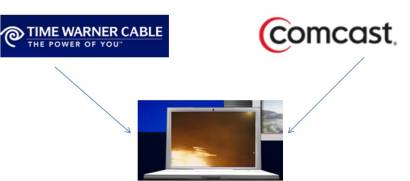
Although we’ve seen some minor attempts by cable operators to let subscribers place-shift their TV programs – witness Comcast’s Any Room initiative – for the most part cable TV customers are stuck watching their shows in one place. Today several news outlets are reporting that the big cable companies have a plan in the works to change that. Time Warner Cable and Comcast are both looking to make their content available online to existing subscribers. The service would theoretically replicate Slingbox functionality, except without the extra box.
I have extremely mixed feelings about what Comcast and TWC are trying to do. As a consumer, this doesn’t do much for me. So much TV is already available on the Internet, I don’t feel like I’m missing much. On the other hand, it makes sense for cablecos to start aggregating content online. They need a presence on the Web, and as long as consumers are using up their bandwidth to watch TV online, the cable companies may as well be getting some of the revenue. In other words, what’s the downside?
The TV industry as a whole is still struggling mightily to figure out how to evolve existing business models. Online video doesn’t make a lot of money because it doesn’t have huge audiences. But once there are massive numbers of viewers on the Web, the industry will face major new issues including bandwidth, quality assurance, and how to avoid giving away the store for free with limited commercials (i.e. Hulu). Some argue that this is an opportunity to move to an a-la-carte TV model, but frankly, that’s idiotic. The economics don’t work, and ultimately consumers will end up only with bland fare appealing to the lowest common denominator of television viewers. Creativity needs some subsidization, otherwise a lot of good shows won’t be given the time they need to develop.
I’ve digressed a bit here, but the point is that TV and Internet providers still have a lot of sorting out to do. The move by Comcast and Time Warner Cable to put more content online isn’t a big one, but it is important… as a first step.
Isn’t the key to this that they’re going to want to get rid of the free access that’s there now?
*snort* this from a company that won’t let two DVR’s talk to each other on the same LAN to share content (I”m looking at you too direct tv). Honestly I don’t expect much from them.
That’s not the key today, though I know that’s what some are touting. Can you imagine the riots in the streets if all of the content available for free on Hulu suddenly went to a pay model? (plus, Hulu is actually doing well in selling its -admittedly limited – ad inventory)
That said, we will eventually end up with some kind of hybrid model. Just giving away content for free online isn’t sustainable. I’m hoping the cable operators figure out how to offer some kind of added value with their content delivery (personalization? back catalogs? longer availability windows?) that gives them a service customers are willing to pay for while preserving the free model as well.
I am a TWC subscriber and can now view online content on my smartphone via Skyfire mobile browser. If I can get a an ccount to view online TWC content without havintg to pay more or just a nominal fee for site maintenance ;) then I suddenly have mobile cable TV – even if it is shows that have previously aired. I really just need an aggregator and the free net people may not like this viewpoint but I think the cable networks have nicely aggregated much of the commercial content I wnat already. I would like to see them do well in the online market and keep me with one bill for them and then one for netflix.